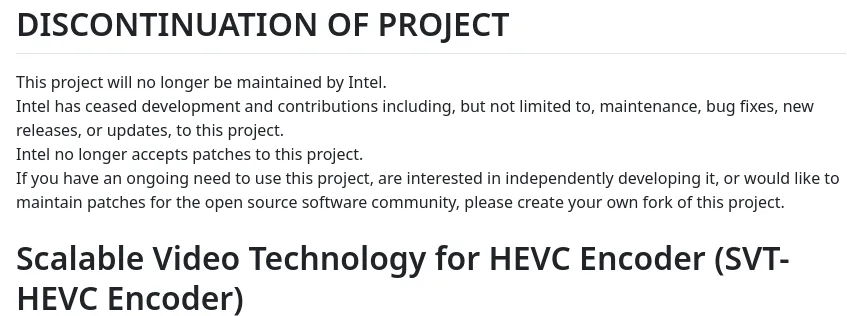As part of Intel’s Scalable Video Technology (SVT) initiative they had been developing SVT-HEVC as a BSD-licensed high performance H.265/HEVC video encoder optimized for Xeon Scalable and Xeon D processors. But recently they’ve changed course and the project has been officially discontinued.



Intel might not even be around in 10 years unless they can suddenly release revolutionarily reliable and efficient yet capable chips to compete with ARM. If I were in charge over there, I’d switch course to RISC-V and skate to where the puck is headed. Perhaps I’m a fool for that idea but the future certainly ain’t x86 …that’s for SURE.
I do think they’re on a decline, but enterprise moves SLOW and that’s big money. ARM is going places, but the x86 market could almost just freeze entirely and still be worthwhile for legacy applications for a very long time.
And from what I’ve read, ARM has a way to go to best x86 for all-out performance, which is primary to servers. Reduced power consumption is nice, but we’re already maximizing clock cycle usage (power utilization) with virtualization. If you have to install even 5% more servers to meet demand, there’s no value in it.
It’s not that black and white. In cloud computing ARM already beats Intel and AMD at single-core workflows and are more price competitive even with higher RAM requirements. They also beat Intel in multi-core workflows, but AMD is far ahead yet.
And give up their only advantage? That would be insane. RISC-V isn’t quite mature enough to replace x86 anyway.
They could, perhaps start investing in the maturity of RISC-V was my point (a pipe dream). I know it’s not there yet but that’s simply because there’s so much money to be made by licensing closed architectures like x86 and ARM. If RISC-V had parity with x86 or ARM, it would be able to best them someday, IMO.
I couldn’t disagree more.
That’s fair. Please elaborate. I think others have made valid points refuting my hypothesis so please, if you will, pile on. I really don’t mind being wrong.
The points someone else made about servers was an excellent one. That was a blind spot in my hypothesis.
If I’m not mistaken, isn’t the N100 chip actually pretty good? It uses like 5 more watts than similar ARM equivalents while still having plenty of power.
At least when it comes to mind pcs